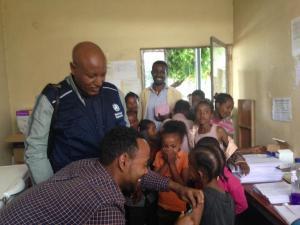Ethiopia to vaccinate more than 1 million people against yellow fever
Addis Ababa, 16 November 2018 – The Ethiopian Ministry of Health, in collaboration with the World Health Organization (WHO) and partners, today started a second vaccination campaign to protect high-risk populations against yellow fever. More than 1.3 million people will be protected in this seven day campaign, which follows a smaller, more focused campaign in October.
The vaccination campaign uses doses from the global emergency Yellow Fever vaccine stockpile managed by the International Coordination Group on Vaccine Provision (ICG) and funded by Gavi, the Vaccine Alliance. Gavi will also provide operational costs for the campaign. The ICG coordinates the timely and equitable provision of vaccines during outbreaks and maintains an emergency stockpile of six million doses of yellow fever vaccine, which is continually replenished.
“This expanded vaccination campaign is focusing on people who are most at risk, to keep them safe from yellow fever and to prevent any further spread of the virus in Ethiopia,” said Dr Paul Mainuka, the acting WHO Representative in Ethiopia.
The first suspected cases of yellow fever in Ethiopia were detected at the end of September 2018. In response, health authorities, WHO and partners deployed a rapid response team to investigate the cases and to strengthen ongoing efforts to stop transmission of the virus. As part of these initiatives they implemented a rapid immunization campaign which reached 32,000 people considered at highest risk in seven Kebeles in Offa Woreda in Wolayita zone of Southern Nations, Nationalities, and Peoples' Region (SNNP) of Ethiopia from 13 to 19 October.
Official confirmation came on 22 October 2018 when the country received results from the Institut Pasteur in Dakar. No new cases have been reported in Ethiopia since then, but efforts to assess risks and stop the transmission of the yellow fever virus are continuing.
This second vaccination campaign aims to immunize people above nine months old in other high risk areas of Offa which were not part of the first campaign and eight surrounding woredas: Kindo Didaye, Kindo Koysga, Sodo Yuria, Sodo Town, Damot Sore, Humbo, Boreda, and Kucha.
In addition to helping coordinate the reactive vaccination campaign, WHO is contributing to the yellow fever response in Ethiopia through providing technical guidance on the disease and how to treat patients, controlling the mosquitoes that spread the disease, and working with communities to help them understand how to protect themselves.
Yellow fever is a viral infection transmitted by infected mosquitos, which can be deadly but easily prevented by a safe and effective vaccine. The disease has re-emerged as a public health threat in many parts of Africa and South America, due to several factors including climate change, rapid urbanization, and increasing population movements.
The response to the outbreak in Ethiopia is part of a global Strategy to Eliminate Yellow Fever Epidemics (EYE) by 2026. With the support from WHO, Gavi, UNICEF, and more than fifty partners, the country will expand its routine childhood immunization programme, improve its laboratory capacity and roll-out control measures to prevent the spread of the disease.
Ethiopia is a priority country for the EYE Strategy, which supports 39 other at-risk countries, 26 of them in Africa. As part of the EYE Strategy, more than 80 million people are expected to be protected from yellow fever through nation-wide preventive mass vaccination campaigns over the next few years.
Communications Manager
WHO Regional Office for Africa
Email: okas [at] who.int (okas[at]who[dot]int)
Tel: +242 06 508 1009
Email: gutcherl [at] who.int (gutcherl[at]who[dot]int)
WHO Yellow Fever Communications Officer
Email: biancov [at] who.int (biancov[at]who[dot]int)
Tel: +41 78 867 4043
WHO Ethiopia HSS Team Leader/Blood Safety Program Coordinator
Tel: +251922534312
Email: mainukap [at] who.int (mainukap[at]who[dot]int)



